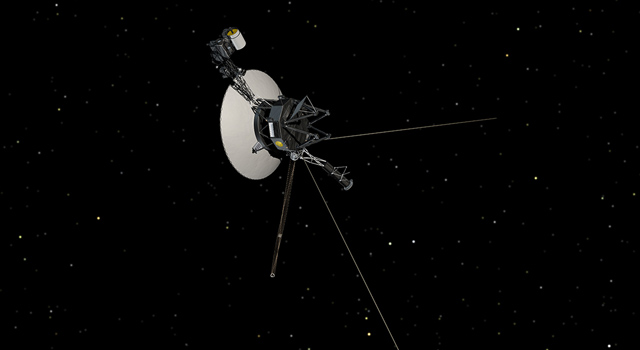News | August 1, 1977
Voyager Will Carry Earth Sounds Record

On the chance that someone is out there, NASA has approved tie placement of a phonograph record on each of two planetary spacecraft being readied far launch next month to the outer reaches of the solar system.
The recording, called "Sounds of Earth" was placed Friday (July 29) aboard the first of two Voyager spacecraft scheduled to be launched to Jupiter, Saturn and beyond.
The 12-inch. copper disc contains greetings from Earth people in 60 languages, samples of music from different cultures and eras, and natural sounds of surf, wind and thunder, and birds, whales and other animals.
The record also contains electronic information that an advanced technological civilization could convert into diagrams, pictures and printed words, including a message from President Carter.
The main Voyager objective is to conduct a detailed scientific investigation of giant Jupiter and ringed Saturn, 11 of their moons and possibly Uranus, before leaving the solar system to journey nearly endlessly among the stars.
The messages on the record were designed enable Possible extraterrestrial civilizations who might intercept the spacecraft millions of years, hence to put together some pictures of 20th century Earth and its inhabitants.
"Because space is very empty there is essentially no chance that Voyager will enter the planetary system of another star," said astronomer Carl Sagan of Cornell University. "The spacecraft will be encountered and the record played only if there are advanced spacefaring civilizations in interstellar space."
"But, as the beautiful messages from President Carter and Secretary General Waldheim indicate," he added, "the launching of this bottle into the cosmic ocean says something very hopeful about life on this planet."
The idea for the record was formulated by Sagan and the repertoire was selected by an advisory committee of prominent scientists, musicians and others. Sagan also was responsible for the plaques with a message previously sent into interstellar space aboard the Pioneer 10 and 11 spacecraft.
A phonograph record was chosen. because can carry much more information in the same space then for example the Pioneer plaques. In addition, 1977 is the 100th anniversary of the invention of the phonograph record by Thomas Alva Edison.
Each record is mace of copper and is in an aluminum protective jacket. It contains, in scientific language, information on how the record is to be played, using the cartridge and needle provided. The record begins with photographs and diagrams in analog form, depicting mathematics, chemistry, geology, and biology of the Earth, photographs of human beings of many countries, and some hint of the richness of our civilization. Included are schematics about the solar system, its dimensions and location in the Milky Way Galaxy, descriptions of DNA and human chromosomes, photographs of Earth, the Voyager launch vehicle, a large radio telescope and human beings in various settings and endeavors.
This is followed by spoken greetings in approximately 60 human languages, including a spoken message by Kurt Waldheim, Secretary General of the United Nations.
The Voyager record next includes a sound essay on the evolution of the planet Earth including sounds of weather and surf, the Earth before life, life before Man, and finally the development of human civilization.
The musical selections, which almost 90 minutes playing ~ ~e, a_~ representative of the c~ cultural d~ diversity of Earth, of many times and ,laces, and include both Eastern and Western classical music and a variety of ethnic music. Included is music from Senegal, Australia, Peru, Bulgaria, and Azerbaijan, as well as jazz and rock and roll. In the classical repertoire are compositions by Bach, Beethoven, Mozart, and Stravinsky , as well as Javanese Gamelan, Indian Raga, Japanese Skakuhachi, and Chinese Ch'in music. The entire 16 2/3 rpm record runs nearly two hours.
Because of the aluminum cover and the emptiness of interstellar space the record is likely to survive more than a billion years. Thus it represents not only a message into space but also a message into time, a point referred to in President Carter's message.
Among the members of Dr. Sagan's committee and others who played a major role in devising the Voyager record are Dr. Frank Drake, Cornell University; Dr. A. G. Cameron, Harvard University; Dr. Phillip Morrison, Massachusetts Institute of Technology; Dr. Bernard Olive, Hewlett-Packard Corporation; Dr. Leslie Orgel, Salk Institute; Dr. Alan Lomax, Choreometrics Project, Columbia University; Dr. Robert Brown, Center for World Music, Berkeley, California; Murry Sidlin, National Symphony Orchestra, Washington, D.C. and artist Jon Lomberg , Toronto, Canada. The record was produced Timothy Ferris; the creative director was Ann Druyan, both of New York City.
The record was prepared for NASA as a public service by Columbia Records. Permission to use copyrighted material on the record has been given to NASA by the owners, also as a public service.
The first Voyager will be launched aboard a Titan Centaur rocket on August 20, and the second or September 1. They will arrive at Jupiter in 1979, Saturn and its rings in 1980, and possibly examine Uranus in 1986. The two spacecraft will be considered to have left the solar system when they cross the orbit of Pluto in 1989.
The Voyager spacecraft will escape the solar system at a speed of 17.2 km/sec (38,700 miles per hour), but this is a slow speed for interstellar distances. It will take at least 40,000 years before either spacecraft approaches another star - passing it at a distance of about one light year (six trillion miles). Other predictable approaches to stars will occur 147,000 and 525,000 years.
